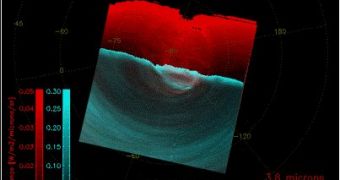The European Space Agency (ESA) has just received infrared pictures of Venus from its nearest probe, Venus Express.
The novelty is that the images have been recorded with the infrared camera that recently went online and started taking beautiful thermal pictures of Earth's sister. The camera is part of a larger sensor system, called Ultraviolet, Visible and Near-Infrared Mapping Spectrometer (VIRTIS).
Venus Express has been capturing atmospheric details of day and night areas simultaneously, at different altitudes and it concentrated on the planet's south pole and the gigantic double vortex that dwells over the entire areas. The new infrared pictures have given the astronomers the opportunity to see the giant vortex as they never did before.
The double vortex is actually a double-eyed huge storm that permanently haunts that area of the planet and the main atmospheric phenomena on Venus.
It represents the best opportunity astronomers have to studying and understanding the global atmospheric dynamics on Venus and will contribute to a better comprehension of the global meteorology of the planet.
Taking advantage of the orbit apocentre (the furthest distance of the spacecraft from the planet), the instrument on board was able to keep the target in the field of view for longer than in other portions of the orbit, where the spacecraft travels faster. In this favorable position, scientists made efficient use of the multi-wavelength capability of VIRTIS.
"It is comparable to looking at bright, sun-illuminated snow and at a dark sky without having to change your glasses," said Giuseppe Piccioni, VIRTIS co-Principal Investigator. "In addition, within this observation process, not only can we look at the dark and lit sides of the south pole at the same time, but we can also look into the atmosphere at different depths. What we are building is the most complete 3D data set of the Venusian atmosphere to date."
This represents an important step that will eventually help the scientists create the best possible atmospheric model of Venus existent so far.

 14 DAY TRIAL //
14 DAY TRIAL //